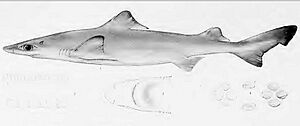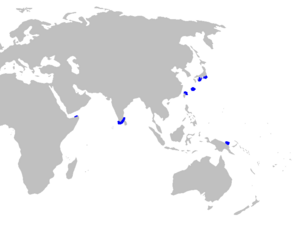Dwarf gulper shark facts for kids
Quick facts for kids Dwarf gulper shark |
|
|---|---|
 |
|
| Conservation status | |
| Scientific classification | |
| Genus: |
Centrophorus
|
| Species: |
atromarginatus
|
 |
|
| Range of dwarf gulper shark (in blue) | |
The dwarf gulper shark (Centrophorus atromarginatus) is a dogfish of the family Centrophoridae found in the Indo-West Pacific oceans, from the Gulf of Aden, Japan, Taiwan, and northern Papua New Guinea, living and feeding at dephts exciding 656 ft (m), marine, deep-water dogfish most commonly found between 328 ft and 3937 ft (100-1200 meters)
Biology
The maximum total length recorded for the gulper shark is 5 ft (150 cm). Gulper shark pups average from 1 to 1.4 ft (30-42 cm) total length at birth. Precise details of the size, age, and growth, such as size at maturity for the gulper shark, are currently unknown. The gulper shark is a slim, relatively long dogfish with two dorsal fins bearing long grooved spines. The second dorsal fin is shorter than the first, and its base is about three-fourths the length of the first dorsal fin. The distance from the first and second dorsal fins is equal to the distance from the tip of the snout to the axil of the pectoral fin. The color of the gulper shark is olive-grey to grey-brown or sandy grey to brown dorsally and lighter ventrally with no obvious markings in adults; juveniles may be lighter and may have dusky tips on the dorsal and caudal fins.
Squalene: a nutritional compound
As a Squaliform, Centrophorus atromarginatus has high amounts of Squalene in its liver, and it is fished for this resource. Squalane is a useful chemical for human health, healthsqualene. Is extracted from dwarf gulper shark and industrially converted to squalane with hydrogen addition. On the other hand, the consumption of its meat is quite limited because high amount of ammonia gradually builds up as the freshness decrease. Using shark muscle for healthy food is important, but not many studies have looked into it beyond making gelatin. We can break down the proteins in shark muscle using enzymes called proteases to get useful parts called peptides. These peptides can help lower high blood pressure by stopping an enzyme called ACE.
High blood pressure is a big problem worldwide, and stopping ACE is one way to manage it. By using different proteases from things like fish, seaweed, shellfish, and milk, we can make shark muscle peptides that lower blood pressure. This not only makes use of parts of the shark that would otherwise be wasted but also lets us make the peptides in different ways to make them work better. Also, we can isolate and study the specific peptides that work best to lower blood pressure. This helps us make better foods that can help with high blood pressure and other health problems.
The family Centrophoridae includes the gulper shark, Centophorus granulosus. Bloch and Schneider first identified the gulper shark as Squalus granulosus in 1801. Centophorus granulosus is the current accepted scientific name for the gulper shark. The Greek words kentron, which means "thorn," and pherein, which means "to bear," are the source of the genus name Centrophorus. These terms refer to the spines that all dogfish have on their first and second dorsal fins. In the eastern Atlantic, gulper sharks are caught using a range of techniques, such as bottom trawls, hook and line, and pelagic trawls. This species is targeted by some deepwater longline fisheries, while it is occasionally caught as bycatch.
A little gulper shark specimen was found in the Norwegian Sea near northern Norway, making it the farthest north this species has been recorded in the eastern North Atlantic Ocean. Based on its physical characteristics, it seems closely related to the Australian species called Centrophorus zeehaani. When scientists analyzed the DNA from the mitochondrial cytochrome oxidase subunit I (coI) gene, they found that the DNA barcoding suggested that C. uyato and C. zeehaani are likely the same species.
In addition, there have been recent revisions to the classification of species within the Centrophorus genus. Currently, four species are recognized in the eastern North Atlantic Ocean: C. granulosus, the lowfin gulper shark (Centrophorus lusitanicus), the leafscale gulper shark (Centrophorus squamosus), and the little gulper shark (Centrophorus uyato). While there is some uncertainty about the validity of the species name C. uyato, it is recommended by White et al. (2013) to use this name for the smaller species of the genus, which was previously often referred to as C. granulosus.
Centrophorus uyato can grow up to 110 cm in total length, with males reaching maturity at 80 cm (White et al., 2013).
This study highlights the northernmost sighting of C. uyato in the eastern North Atlantic Ocean to date. It also provides a summary of the taxonomic characteristics of the four species found in the area and compares their mitochondrial cytochrome oxidase subunit I (coI) sequences.
On 22 February 2011, a commercial longliner named Atlantic deployed a 6000 m longline at depths ranging from 233 to 557 m near the continental shelf off northern Norway (coordinates: 68° 48·5′ N; 12° 54·0′ E). The longline, which consisted of 4000 hooks (size 12/0) arranged in a semi-circle, was baited with Atlantic saury and squid. The line was left to soak from 0150 to 1800 hours GMT, targeting tusk and haddock. The specimen was frozen upon collection, then thawed for a closer look after being brought to land. It has been stored at the University Museum of Bergen in Norway under the accession number ZMUB 21441. To identify the species morphologically, the methods outlined by White et al. (2013) were followed. During examination, a total of 88 morphometric measurements, as defined by Compagno (1984), were recorded for the specimen.


